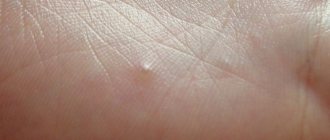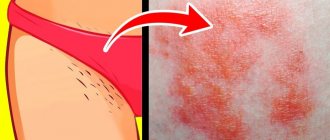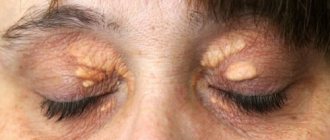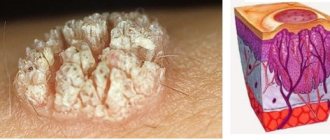- Symptoms of dyshidrosis
- Types of disease
- Complications of dyshidrosis
- Causes of crowberry
- Disease in children and pregnant women
- Diagnostics
- Treatment
- Drugs for the treatment of dyshidrosis
- Hardware procedures
- Diet for crowberry
- Duration of treatment and prevention of the disease
Dyshidrosis is a dermatological disease, otherwise called pompholyx or dropsy. The disease affects the sweat glands.
The main symptom is small blisters filled with fluid. They appear on the skin of the palms and legs and are accompanied by itching. After two or three days, dry crusts form in place of the blisters. As a rule, the disease manifests itself in the off-season.
Dyshidrosis in many cases is a type of allergy or occurs due to an imbalance in the functioning of the nervous system. This disease cannot be transmitted from the patient to other people.
Symptoms of dyshidrosis
The most important sign of dyshidrosis is damage to the skin of the feet and hands. If changes appear in other parts of the body, this means that the patient does not have water, but another dermatological disease.
The main signs of dyshidrosis:
- redness;
- swelling;
- bubbles filled with liquid;
- itching;
- peeling and sloughing of the affected skin.
When you touch the affected area, you may feel that the skin has become hotter.
results
Pronounced positive dynamics of the skin process was obtained in all patients of both groups. In patients of group 1, itching decreased significantly by the 4th day of treatment and completely resolved by the 8-10th day. Fresh vesicular rashes also stopped appearing by the 10th day of therapy. However, 7 (25.9%) patients required additional administration of aniline dyes in order to prevent secondary infection of small cracks that form at the site of resolved vesicles. Complete resolution of the skin process was observed by the 20th day of treatment.
In patients of group 2, the vesicular process was generally characterized by a more persistent course, and itching continued to bother patients until the 10-12th day from the start of treatment. However, the disappearance of itching was more abrupt than in patients of group 1, and practically coincided with the moment the appearance of vesicles ceased; this phenomenon occurred on the 12-14th day from the start of treatment. Vesicular lesions of the hands and feet in 7 patients in this group began to regress simultaneously. Only 3 patients required aniline dyes. Complete resolution of the skin process was not obtained in all patients: out of 20 patients, 4 (20%) had erythematous-squamous lesions in the absence of vesiculation by the 20th day of treatment.
During observation, there were no adverse events in both groups.
Types of disease
There are three types of dyshidrosis, which differ in manifestation and severity:
- True dyshidrosis. At the initial stage, the disease manifests itself as redness, swelling and swelling of the skin. Then bubbles appear on it, the dimensions of which are about a millimeter and do not change in the future. True crowberry affects the skin of the palms. The foci of the disease are located at the base of the fingers. After 7-10 days, the blisters begin to open, which is accompanied by severe itching and burning. If the patient scratches the affected areas of the skin, this can lead to inflammation caused by infection in the wound.
- Dyshidrotic eczema. This is the most severe type, which if left untreated becomes a chronic disease. With eczema, fluid-filled blisters form on the palms and legs and increase in size. After some time, the bubbles open and dry out. The disease develops rapidly and causes a deterioration in overall health. The patient develops a headache, fever, and enlarged lymph nodes. With dyshidrotic eczema in children, appetite decreases and the child becomes lethargic. The disease most often develops with a hereditary predisposition or after severe stress.
- Dry lamellar pompholyx. The peculiarity of the disease is the absence of bubbles. Instead, the skin begins to itch slightly and areas of peeling appear. When itching, the skin can peel off in thin sheets, hence the name of the disease. It is important to know that with dry lamellar dyshidrosis, the skin should not be scratched, as this leads to inflammation and aggravation of the symptoms of the disease.
The disease develops mainly in residents of countries with a humid tropical or very dry climate, and tourists who prefer exotic holidays.
Material and methods
We observed 47 patients (17 men and 30 women) with dyshidrotic manifestations on the skin of the palms and soles. All patients were divided into two groups.
Group 1 consisted of 27 patients with a dyshidrotic form of mycosis of the skin of the feet; There were no hand lesions in this group.
2nd - 20 patients with DE of the palms and soles. Lesions of the soles only were diagnosed in 13 patients, palmoplantar process - in 7; There were no isolated lesions of the hands.
Criteria for inclusion in group 1: vesicular process on the skin of the soles without weeping; detection of mycelium of pathogenic fungi in lesions, the presence of onychomycosis.
Criteria for inclusion in group 2: an established diagnosis of chronic eczema, for which the patient has been observed by a dermatologist for at least 2 years, the presence of seasonality in exacerbations of the skin process, and an undulating course.
Exclusion criteria from group 2: detection of mycelium of pathogenic fungi in the lesions, presence of onychomycosis; the presence of an acute process with weeping.
All patients of group 1 were treated in accordance with clinical recommendations for the management of patients with mycosis of the skin of the feet: systemic therapy consisted of prescribing terbinafine 250 mg orally once a day for at least 16 days; Cetirizine 10 mg once a day for 20 days.
All patients of group 2 were prescribed treatment in accordance with clinical recommendations for the management of patients with chronic eczema: systemic therapy - cetirizine 1 tablet once a day for a course of 20 days; injections of dexamethasone solution 1 ml (4 mg) daily, no more than 5 injections per course.
External treatment for all patients in both groups was carried out according to a similar program: on days 1 and 2, combined corticosteroid + antibiotic aerosols were prescribed to achieve a drying and anti-inflammatory effect; from the 3rd day, patients of both groups were prescribed Tetraderm
, which was applied to the rash areas 3 times a day. In order to obtain a minimal occlusive effect and prevent the development of maceration, the area of application of the cream was covered with gauze or paper napkin in one layer. The bandage was kept on the affected area for at least 2 hours.
The results of treatment were assessed by the dynamics of the following clinical symptoms: itching, dynamics of rashes, the presence of secondary elements (peeling, cracks), and the presence of side effects.
Causes of crowberry
Previously it was believed that the pathology develops when the ducts of the sweat glands become clogged, but at the moment this theory is completely refuted. Most often, the development of the disease is caused by a violation of the innervation of the sweat glands of the skin. This occurs due to a specific reaction of the nervous system to severe stress. In general, experts distinguish several common causes of pathology:
- hereditary predisposition;
- decreased immunity;
- endocrine disorders;
- dermatological diseases (fungi and infectious skin lesions, pyoderma);
- predisposition to allergies;
- diseases of the gastrointestinal tract;
- vegetative-vascular dystonia, other disorders of the nervous system;
- interaction with aggressive chemicals;
- psycho-emotional overload, mental fatigue;
- psychological trauma, severe stress;
- long-term use of antibiotics.
Popular questions about dyshidrosis
How does it manifest?
The disease is characterized by the appearance of itchy blisters on the palms and soles of the feet. Over time, they burst and leave behind areas of peeling. The dry form of dyshidrosis is characterized by dryness and peeling of the skin without the preliminary appearance of vesicles - the mildest variant of the disease.
How dangerous is the pathology?
The pathology is mostly not dangerous, it only causes severe discomfort and pain. If hygiene rules and improper care are not followed, complications may occur in the form of infection and the development of more severe inflammation.
What will happen if left untreated?
Each relapse will take longer and be more severe.
Disease in children and pregnant women
Not only adults, but also children are susceptible to the disease. In infancy, dropsy can occur due to breastfeeding if the child's mother does not eat properly. Breastfeeding women should not consume foods that may cause allergic reactions.
At an older age, dropsy in children occurs due to a hereditary predisposition or against the background of neuropsychic overload. The cause of the pathology can also be a disruption in the functioning of the immune system. During pregnancy, the risk of developing dyshidrosis increases, since in this condition the load on the female body increases. This leads to certain reactions from the nervous system. You should know that it is prohibited to use certain drugs to treat crow's feet in children and pregnant women, as they can cause unwanted side effects.
Possible complications
When scratching or opening the rash on your own, there is a high risk of pathogenic microorganisms getting inside. This leads to an inflammatory process: the blisters turn into pustules. The liquid inside them loses its transparency, acquiring a yellowish color. The discomfort intensifies, severe swelling appears. In some cases, the patient experiences an increase in body temperature.
Other complications of hand dyshidrosis include panaritium and lymphangitis: purulent inflammation of the finger and lymphatic vessel, respectively. In the latter case, a painful cord forms under the skin.
Diagnostics
At the first signs of the disease, you should consult a dermatologist. The patient may also need to consult a gastroenterologist, allergist, or immunologist. The symptoms of the disease are similar to fungal infections and psoriasis, so a whole range of diagnostic procedures are prescribed. It includes:
- fungal analysis;
- allergy test;
- endoscopic examination;
- immunogram.
Thanks to differential diagnosis, the doctor will determine the exact nature of the disease and choose a treatment regimen.
Rules for applying ointments
When using ointments, you must adhere to certain recommendations:
- Before manipulation, clean the affected area. In this case, the wound can be washed with Chlorhexidine. Wash and disinfect hands.
- A little ointment is evenly distributed on a sterile napkin. Sometimes it will be more effective to apply the drug using your fingers.
- Cover the affected area of the skin with a napkin.
- You must wait until the ointment is absorbed. Do not rub or rub in the medicine. Such movements can damage the top layer of inflamed skin.
Drugs for the treatment of dyshidrosis
Treatment of the disease includes medications for external use and oral administration. To reduce symptoms, affected areas of the skin are treated with antiseptics based on boric acid, chlorhexidine and other disinfecting compounds. To reduce swelling and redness, use zinc and salicylic ointment and other anti-inflammatory drugs.
Antihistamines are prescribed for oral administration, which relieve allergy symptoms. The patient is also prescribed sedatives, which reduce the sensitivity of the nervous system to psycho-emotional stress. To improve the functioning of the immune system, immunostimulants are used. In severe forms of the disease, glucocorticosteroids are indicated.
Discussion
Tetraderm cream
is a combination drug of the following composition: mometasone furoate 0.05%, gentamicin sulfate 0.1%, econazole nitrate 1%, dexpanthenol 5%.
The light creamy texture of the drug is achieved using a unique ratio of excipients included in the pharmaceutical base: 1 g of the drug contains liquid paraffin 120 mg, cetostearyl alcohol 70 mg, propylene glycol 50 mg, macrogol 6 cetostearyl ether 20 mg, macrogol 25 cetostearyl ether 20 mg , sodium dihydrogen phosphate dihydrate 2 mg, purified water to 1 g [17].
This drug, when applied to the skin, provides a pronounced anti-inflammatory, antimicrobial, antifungal effect, and also stimulates reparative processes in the skin [17].
Diet for crowberry
Patients with dyshidrosis caused by food allergies need to review their diet and exclude foods that increase the manifestations of an allergic reaction. Such products include:
- dishes high in salt, spices, herbs;
- honey;
- citrus fruits, berries, bananas, melon;
- nuts;
- Fish and seafood;
- chocolate, cocoa, coffee;
- alcoholic drinks;
- eggs;
- foods high in sugar, baked goods.
When treating dyshidrosis, it is worth focusing on fermented milk products, cereals, fresh and boiled vegetables. The diet of a patient with chronic dyshidrosis should contain enough foods high in iron and phosphorus.
Price table for ointments for dyshidrosis
To combat dyshidrosis, you can use either one ointment or several drugs. The cost of medicinal ointments depends on their component composition. But minimum prices do not always indicate the lack of effectiveness of the drug.
Let's consider the main pricing range for medicinal ointments against dyshidrosis:
| A drug | Price range in rubles for 2022 |
| Fluorocort | 230-300 |
| Losterine | 419-547 |
| Triderm | 620-780 |
| Elokom | 330-373 |
| Laticort | 135-183 |
| Salicylic ointment | 23-25 |
| Ichthyol ointment | 82-120 |
| Zinc ointment | 27-37 |
| Tetracycline ointment | 39-46 |
| Levomikol | 102-124 |
Dyshidrotic eczema of the hands
In the development of this type of dyshidrosis, all of the listed reasons are important, to which can be added prolonged exposure to the skin
- industrial hazardous substances;
- solar radiation
- local hypothermia;
- traumatization.
Doctors make a diagnosis of dyshidrotic eczema if the disease does not end with a single eruption of blisters, but their number increases with nervous stress, and an infection occurs. The patient's general condition worsens. Appear
- weakness;
- fever;
- headache;
- soreness of the skin of the palms, fingers, along the lymphatic vessels.
Clinical manifestations of eczema may be more striking than true dyshidrosis.
- Bubbles with liquid are large in size, merge and open with the formation of weeping erosion.
- The skin of the hands is swollen and there is a change in its color.
- Bubbles can appear not only on the palm, but also on the back of the hands.
Dyshidrotic eczema on the fingers photo:
For proper treatment, dyshidrotic eczema should be differentiated from other types of hand skin diseases:
- fungal infection;
- contact dermatitis;
- psoriasis
- Andrews pustular bacterid;
- chronic form of acrodermatitis Allopo.
Folk remedies for dyshidrosis
Dyshidrosis of the legs, like other parts of the body, can be treated using traditional medicine. Treatment with folk remedies involves various herbal baths, lotions, compresses, ointments. Their use is very effective and also safe for the body as a whole.
Herbs such as chamomile, calendula, sage, string, St. John's wort, wormwood, oregano, celandine, yarrow, oak bark, rosemary, eucalyptus, blackberry leaves, blackcurrant leaves and branches and even horseradish have proven themselves to be excellent in treating this disease.
All these plants contain substances with antimicrobial, regenerating, antiseptic, moisturizing, soothing, and wound-healing effects.
Folk recipes
In the complex treatment of skin pathologies, in particular dyshidrosis, “old-fashioned” methods can also be used. Before using folk recipes for this category of patients, it is necessary to consult a dermatologist.
This is due to the fact that many medicinal herbs have contraindications, so it is extremely important to determine before starting treatment whether they can be used by the patient
If the patient does not have individual intolerance to medicinal herbs, then they can use the following recipes when carrying out complex therapy for dyshidrosis:
- You can take baths with herbal infusions. Chamomile inflorescences, sage grass or strings are excellent for these purposes. You should pour a mixture of these medicinal plants (6 tbsp) into a saucepan and pour boiling water (1 l) over it. After this, place the container on low heat and bring its contents to a boil. Next, remove the saucepan from the stove and cool. The liquid that has been infused for half an hour must be filtered and its volume brought to 3 liters.
- Experts recommend making baths from a decoction of oak bark. To prepare it, you need to take a saucepan, pour oak peels (5 tbsp) into it, and pour boiling water (1 l) over them. The contents of the container must be brought to a boil over low heat, then simmer for 20 minutes. The mixture should infuse for 30-35 minutes, after which it should be strained.
Preventive actions
People who have encountered this skin pathology should carry out its prevention, which will prevent relapses:
- Experts recommend that patients follow a daily routine.
- You should find time for proper rest.
- Patients should minimize stressful situations.
- When contacting household chemicals, it is necessary to use personal protective equipment.
- You need to take vitamin and mineral complexes.
- Cosmetics used by patients must be of high quality and contain natural ingredients.
Dyshidrosis is characterized by damage to the human skin; the disease is especially pronounced on the arms, palms and fingers, legs and soles of the feet.
The cause of its occurrence is obstruction of the sweat glands.
As a result, the skin becomes covered with blisters that itch and hurt. When the blisters open, crusts and cracks form, and open wounds can become infected.
When making a diagnosis, other dermatological diseases that have similar signs and symptoms must be excluded.
Treatment is carried out comprehensively, and physiotherapeutic methods are widely used.
Correct diagnosis, early therapy and regular prevention help to completely get rid of the problem and eliminate the risk of relapse.
Folk remedies
Treatment with folk remedies has a positive effect in combination with traditional drug treatment.
As a rule, infusions and decoctions of medicinal herbs are used. Here are some of the effective folk recipes:
- Take 2 tablespoons of sage, chamomile, string and pour 2 liters of hot water over the herbs, boil for 5 minutes, then leave covered for half an hour. Strain and dip your hands in the infusion for 20 minutes.
- Pour a handful of crushed oak bark into a liter of water, boil for 15 minutes, then let it brew and cool slightly. Place your hands in the warm broth and hold for 20 minutes.
Folk recipes to cope with this disease include bath recipes. These include:
Baths with chamomile, string and sage.
A mixture of chamomile, sage and string.
In this case, you will need 5 tablespoons of the plant, which are filled with 5 liters of water. Boiling the mixture over low heat lasts no more than 20 minutes. Then you need to leave it for 30 minutes and then strain. The procedure time does not exceed 25 minutes.
The natural remedy Oak Bark can be purchased at any pharmacy.








